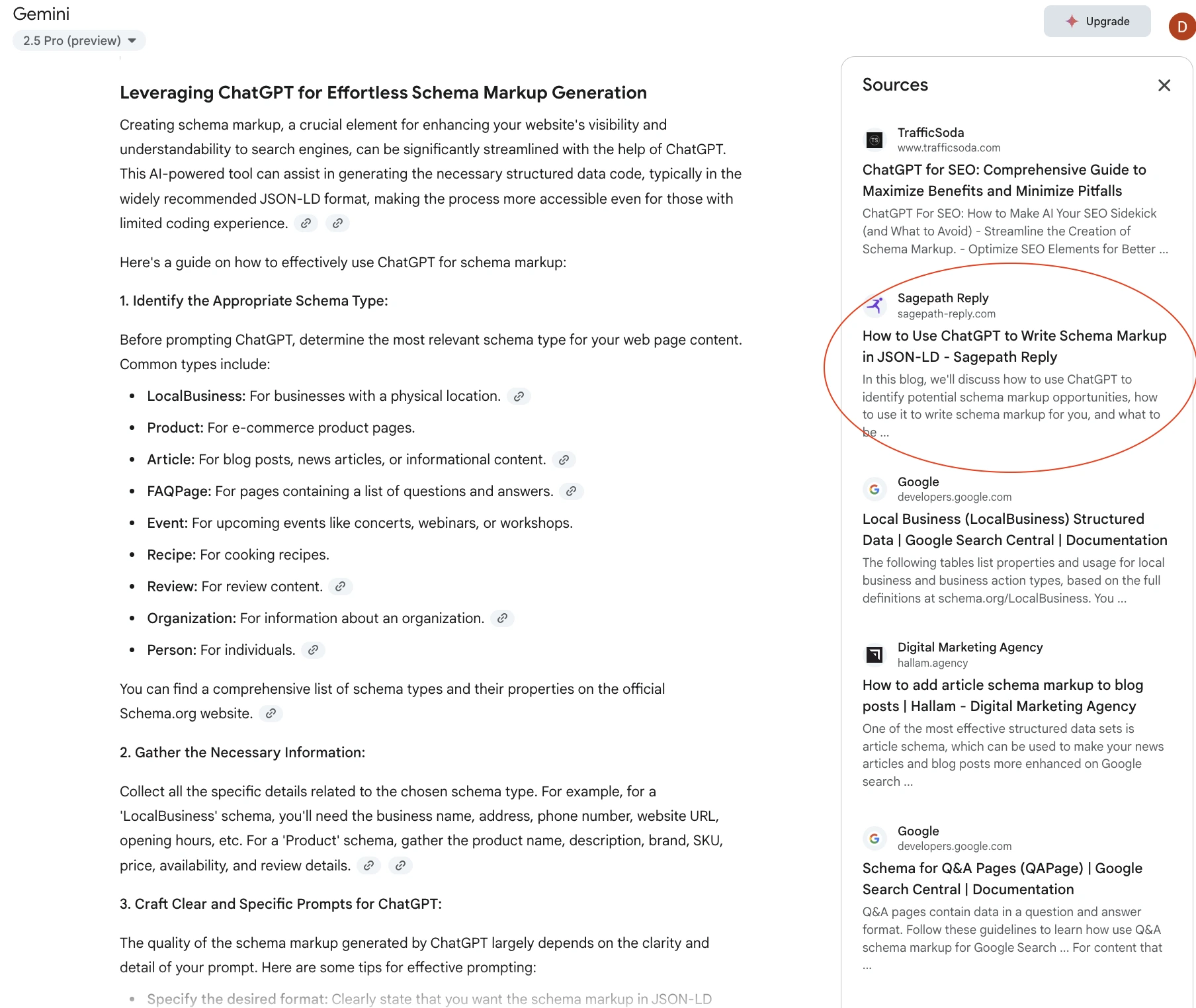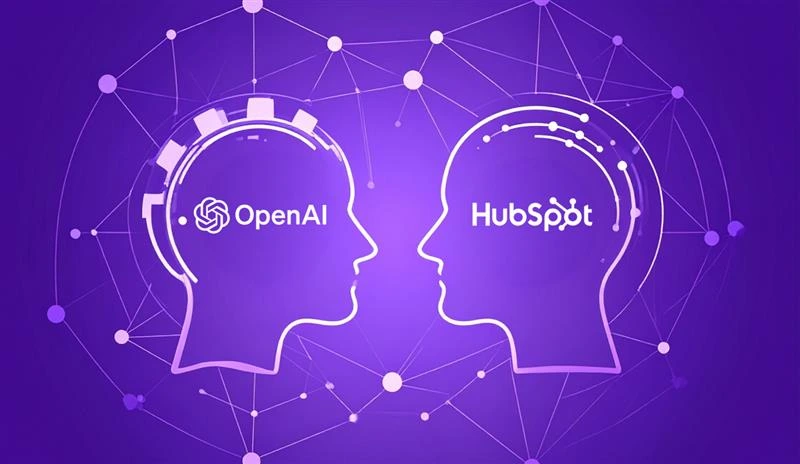How to Optimize Content for Generative AI Search Engines

As generative AI reshapes the way people interact with search engines, sporadic traditional SEO tactics are no longer enough. You must be nimble and shift your SEO strategy to ensure visibility in both organic search and generative search. That shift is known as generative engine optimization (GEO), and it’s quickly becoming essential for modern marketers and content creators.
But the good news? If you’ve been following SEO strategies on your website and when creating content—and have made Google’s Helpful Content Guidelines your source of truth—you’re already on the right track.
Our blog on using ChatGPT for writing schema markup has been successfully cited in Google searches via AI Overviews for quite some time now and has more recently been cited in ChatGPT. Based on my personal and professional success with optimizing for generative search, I’ll break down what generative search results are and how to optimize your content to appear in them.
What Are Generative Search Results (GSRs)?
Generative search results are AI-generated responses that synthesize information from multiple web sources to answer search queries in natural language. These answers often appear at the top of search results in a visually distinct summary box.
Unlike featured snippets that cite a single excerpt, GSRs pull from several sources and blend the information into a unified narrative—sometimes citing websites, sometimes not.
Examples include:
- Google SGE’s AI snapshots
- Bing’s Copilot sidebar results
- LLMs like Perplexity, Gemini and ChatGPT
With tools like Google's Search Generative Experience (SGE), Perplexity, and ChatGPT delivering AI-generated responses directly in search query results, visibility now depends on how well your content is interpreted, summarized, and surfaced by AI-powered search engines.
If your content isn’t optimized for this new mode of discovery, you won’t get nearly the same amount of organic exposure as you would optimizing it for search generative experiences.
How Generative Search Chooses Content
To be included in GSRs, your content must align with how large language models (LLMs) read and rank value. Understanding how to optimize for AI search and how to optimize for AI overviews is key. The primary factors include:
- Experience, Expertise, Authoritativeness, and Trustworthiness (E-E-A-T): Content needs credible authorship and real-world perspective.
- Semantic Clarity: AI prefers structured content that’s well-organized, easy to parse, and clearly answers questions.
- Topic authority: Websites that cover a topic comprehensively and interlink strategically are more likely to be referenced.
- Structured Data: Schema markup helps AI interpret the type and purpose of your content—boosting your SEO efforts.
How to Optimize Content for GSRs
You need more than traditional SEO to succeed in AI-powered searches. Below are generative AI search optimization tips and steps you can take today to improve your content’s discoverability.
Keyword Research: Prioritize Longtail Question Keywords
To succeed at generative AI search engine optimization, you need to understand what questions users are asking—and how they’re phrasing them. Longtail and question-based keywords perform better with AI models, while outdated tactics like keyword stuffing can hurt your rankings.
Use these tools and techniques:
- Semrush, Ahrefs, Google Keyword Planner: Use seed keywords to find longtail queries.
- Google Search Console: Filter queries to surface “what,” “where,” and “how” terms.
- People Also Ask: Expand visible queries by interacting with this SERP feature.
- AnswerThePublic: Get visual maps of question-based search behavior.
Content Formatting: Clean, Parsable Structure
The way your content appears on a webpage is almost as important as the helpfulness and completeness of the content itself. Let’s explore how to structure clean content that search engines and users will love.
1. Lead with Clear, Direct Answers
AI models prioritize content that answers a question fast. Use the inverted pyramid model: answer the main query in your opening lines, then elaborate. Use bullet points, structured content, and short summaries to improve clarity.
This is a foundational generative search optimization technique that supports both machine understanding and user engagement.
2. Use Schema Markup Strategically
Structured data like FAQPage, HowTo, and Article schema helps search engines and AI-powered search engines understand your content. It’s a core part of how to optimize content for AI search engines and improving your visibility in AI-generated responses.
3. Demonstrate First-Hand Experience
AI favors content with original thought. Use author bios, real-world examples, or case studies. This adds authenticity and aligns with how to optimize for generative AI systems that favor trustworthy perspectives in content creation.
4. Build Topic Clusters
Instead of scattered content, interlink related articles around a central theme. This improves topical authority and supports generative AI search optimization by helping models understand your site’s expertise across multiple angles.
5. Write for Conversational Search
Users increasingly phrase queries in natural language. Use headings like:
- “What is generative search optimization?”
- “How to optimize for AI search engines”
- “How to optimize content for AI search”
This aligns your content with how modern users interact with AI-powered searches, and with how large language models (LLMs) parse queries.
6. Use AI to Audit Your Content
Run your top-ranking pages through tools like ChatGPT or Gemini. Ask them to answer a question using your page. If it’s not referenced or is summarized incorrectly, reformat and clarify.
This is a real-world method of how to optimize for AI overviews and test your content’s readiness for surfacing in AI-generated responses.
When checking on the success of our blog about how to use ChatGPT for schema markup, I followed the process of checking different generative search engines, including ChatGPT, Gemini, Google’s AI-mode, and Perplexity. In the following screenshots, you’ll see how our blog was cited across all of the most popular generative search engines.
Example 1: Gemini

Example 2: ChatGPT Deep Research

Example 3: Perplexity

Example 4: Google AI Mode

How to Measure Generative Search Success
AI overviews don’t always link directly, but you can monitor:
- Mentions or citations in AI summaries
- Changes in click-through rate (CTR) for target keywords
- Growth in branded search volume
- Session duration and on-page engagementFuture-Proofing GEO for the GSR Landscape
The key is to continue refining SEO strategies and adapting formats for structured content as search evolves.
SEO isn’t just about ranking anymore—it’s about being recognized and summarized by AI. That means learning how to optimize for generative AI and writing for both machines and humans.
Search is evolving. To stay visible in AI-powered search engines:
- Refresh content regularly
- Broaden schema coverage across content types (text, video, audio)
- Monitor how your industry is represented in generative search results
By embracing generative engine optimization (GEO), your brand can remain relevant, visible, and competitive in the world of AI-powered search engines.
Ready to Future-Proof Your SEO & GEO Strategy?
Staying visible in AI-powered search results requires more than traditional SEO—it demands a shift to generative engine optimization (GEO). The search optimization experts at Sagepath Reply are here to help you make that shift with confidence. From strategy to execution, we’ll guide you in optimizing content that AI can understand, summarize, and surface.
Ready to take the next step? Talk to our team and future-proof your content for the evolving search landscape.
🇮🇹 🇫🇷 🇩🇪 Based in Italy, France, or Germany? Like Reply—our local Reply network partner—can help you unlock GEO success in your market. Connect with their experts today.
About The Author:
Dylan Goldman, Sr. SEO & GEO Manager | Sagepath Reply
Dylan is a search engine optimization (SEO), content strategist and copywriter with over 15 years of experience helping enterprise brands increase their organic visibility and drive measurable growth. Working with Fortune 500 and 1000 companies, he specializes in keyword research and optimization, technical SEO, schema markup, and high-level content strategy. Dylan is also leading initiatives in Generative Engine Optimization (GEO), helping organizations prepare their content for AI-driven search experiences and emerging answer engines.

Let’s Start a Conversation
Reach out to discuss your digital transformation needs and see how we can help. We would love to start a long-term partnership with your company.
Get in Touch


